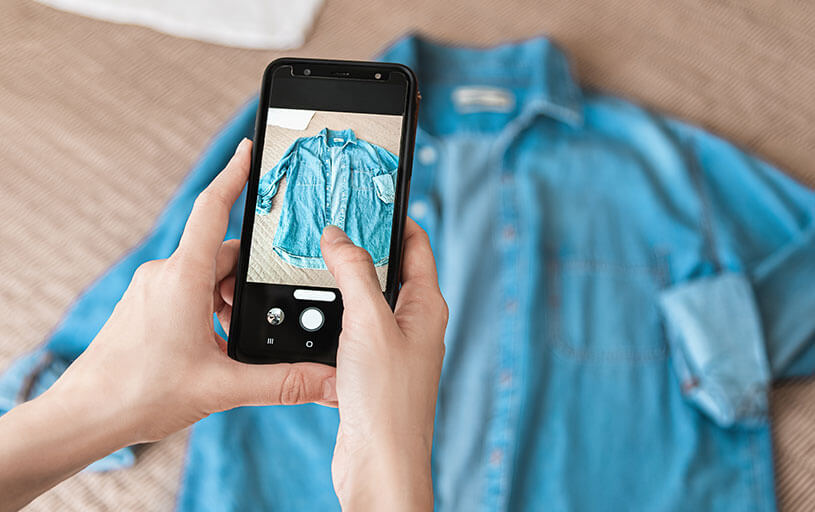If you already have a clothing business then you might be wondering how you can reach more customers by selling on Depop.
Sustainable fashion, vintage pieces, and upcycled or tailored clothing are growing in popularity as people look for ways to reduce their impact on the planet.
So whether you have a bricks-and-mortar shop, tailoring service, or an online brand, read on for a step-by-step guide to setting up your Depop shop.
Analysis of Google Trends data reveals a rise in online searches for sustainable fashion and second-hand clothing, so here are some quick tips to help small businesses take advantage of this trend on Depop.
How does Depop work?
Depop is an app designed for selling second-hand clothes – and it’s quickly become more than a way to clear your wardrobe of unwanted or unworn clothing.
It feels a lot like a social media app as you build a community of followers who want to engage with your products. Each item you list for sale is added to a grid on your profile page and users can like, comment, and share (as well as buy) from your shop.
Both sellers and buyers get a rating based on their service and communication, so there’s a mutual system of feedback – similar to the taxi app Uber or eBay. And while you’re probably familiar with eBay, Depop is specifically for fashion and has a younger audience ready to buy pre-loved items.
- How to start a Depop business
- What can you sell on Depop?
- Boost your marketing
- Depop payments
- Depop tax and legal responsibilities
- Do you need a business licence to sell on Depop?
How to start a Depop business
Follow these seven steps for how to sell on Depop.
1. Name your shop
Your Depop shop name is probably going to be your brand name so you can build a brand identity. If you haven’t got a name yet, try out our Business Name Generator for a bit of fun inspiration.
2. Choose your products
Next, select the items you want to sell. It’s worth bearing in mind how each listing will appear on the grid so there’s a consistent look and feel.
3. Take creative photos
Take a selection of photos to show off your products, thinking carefully about your background and lighting to get the best shots. Use a model for one shot and then take one of the item laying flat and a few close ups.
4. Create your listing
A good title and product description will help sell your fashion items, so make sure you include key features and details here. You can also use hashtags to boost your reach.
5. Get noticed
Listing products regularly helps boost your profile to potential customers. Depop recommends posting about 15 items a week to increase your visibility on the app. It’s also possible to connect your Instagram account and use Stories to drive sales.
6. Shipping
When you’ve made your first sale, it’s time to ship your products. You can choose whether you just want to ship within the UK or internationally. Think about packaging and a message to include with your item to give a personal touch. And don’t forget to mark the item as ‘shipped’ and share the tracking information with your buyer.
7. Rate your buyer
Leaving a review of your buyer is a great way to encourage them to leave one for you. A positive seller rating over time is going to help encourage more people to buy from your shop.

Photograph: 22Imagesstudio/stock.adobe.com
What can you sell on Depop?
A marketplace for second-hand fashion, you can sell anything on Depop from clothes and shoes to bags and accessories.
There are three main categories:
- Menswear
- Womenswear
- Jewellery
Boost your marketing
If you have an existing shop but want to reach more customers, using a platform like Depop with millions of users can help get your brand out there.
Latest figures from Depop say there’s 26 million registered users in 150 countries, with 90 per cent under the age of 26. And while many of these users might be sellers themselves, it’s hard to deny the far-reaching audience across the world.
In a recent webinar for Simply Business, BBC’s The Apprentice 2022 winner Harpreet Kaur shared her advice: “You don’t need to be on every platform, but it’s really key to investigate which platforms are the right ones for you. Don’t restrict yourself to your own social media page, get onto those platforms and you’ll reach a wider audience because they’ll do the marketing for you.”
Do I need a Depop business account?
If you’re a charity or limited company, you might want to set up a Depop business account. You’ll need to share company information, including registration number, address, and details of owners and directors.
Learn more about setting up a Depop business account.
Depop payments
It’s easy to manage a Depop payment in the app using your Depop Payments account. Once the account is set up, buyers will be able to pay through Apple Pay, Google Pay, credit and debit cards, and Klarna. You’ll get paid directly into your bank account around one to two days after you make a sale.
PayPal removed as a payment method
Depop has announced they’re cutting PayPal as a payment option for buyers using the online marketplace. From 23 October 2023, buyers and sellers will need to have a Depop Payments account set up to process transactions in the UK and US.
PayPal shipping labels won’t be available after the transition date either, instead you can choose to use Depop Shipping for your shop.
The app says the change is to provide a more “streamlined and efficient buying and selling experience”. You can find out more about the change on the Depop website.
How much does Depop take?
Depop charges a 10 per cent fee based on the final sale price and shipping cost. The fee is deducted from your Depop Payments account 21 days after the sale.
They sometimes run special offers for sellers, so keep an eye out for Depop no fees deals by following Depop on Twitter.
Depop tax and legal responsibilities
If you’ve already got your clothing business up and running then you’ll be well aware of the need to register with HMRC to pay your tax bill.
Even if Depop is more of a side business for you, you’ll still have tax responsibilities if your income is more than £1,000 in any tax year.
You can also claim back certain business expenses on your tax return, such as:
- listing fees
- postage costs
- photography equipment
- craft materials
- marketing costs
Do you need a business licence to sell on Depop?
You don’t need any particular licences, but protecting yourself and your business with insurance is sensible. For example, you could be liable if a customer is injured as a result of a faulty product you’ve sold.
Tailored insurance for online retailers includes things like product liability insurance and stock cover.
Are you going to be shipping internationally? Make sure you’re aware of different regulations and customs rules in the country you’re shipping to.
‘One-of-a-kind clothing that lasts longer’
Trends are moving away from fast-fashion and people are looking for authentic, quality items that are going to last.
Evie, owner of clothing store and Ever-Kind Depop shop, said: “We have definitely seen an increase in demand for sustainable fashion in the past year. More and more people are realising that you can invest in amazing quality, one-of-a-kind clothing that lasts a lot longer than clothes from fast fashion retailers.
“Some of our best sellers at the moment are Vintage cowboy boots, cargo trousers and workwear shorts.”
Are you considering Depop selling as a business opportunity? Let us know how you get on in the comments.
Useful guides for starting your own business
- How to create a sustainable fashion brand – tips from the experts
- Vinted tax: how to sell on Vinted as a small business
- 9 best apps for selling clothes online
- Why do I need business insurance?
Ready to set up your cover?
As one of the UK’s biggest business insurance providers, we specialise in public liability insurance and protect more trades than anybody else. Why not take a look now and build a quick, tailored quote?
